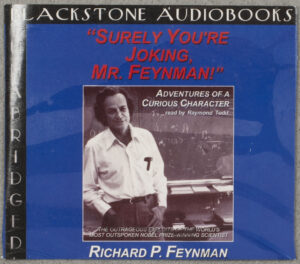Published: Ashland, Ore., 1997
Surely you’ve heard of Richard Feynman! Library shelves groan under the weight of books by and about the illustrious theoretical physicist. In addition to his towering scientific contributions, he was an expert safecracker, player of the bongos and the frigideira, visual artist (pseudonym “Ofey”), fan of Tuvan throat singing, and prankster extraordinaire. You couldn’t make this guy up – though “Richard Feynman” has also been a character on screen and on Broadway. It’s not everyone who’s been played by both Alan Alda (in QED at Lincoln Center) and Matthew Broderick (in the bio-pic Infinity).
A Nobel Prize winner in 1965, Feynman made contributions to many of the most significant developments in physics of the 20th century. He won the Nobel for his work in the 1940s on the theory of quantum electrodynamics (or QED), which deals with the interaction between light and matter. With his “sum over paths” approach, he reformulated QED, which had been mathematically unwieldy and untidy, the equations sometimes breaking down and yielding infinities. The notation he developed to represent the interactions of elementary particles in an intuitive way, christened “Feynman diagrams,” revolutionized theoretical physics.
In addition to his work on QED, Feynman devised a quantum-mechanical explanation for the superfluidity of helium in 1953; he developed a theory with Murray Gell-Mann of the weak force (the force behind radioactive decay) in 1958; and he posited the existence of point-like sub-nuclear entities he called “partons” (later to be reconciled with Gell-Mann’s quarks) while working with experimenters at the Stanford Linear Accelerator in 1968. Oh, and did we mention he was part of the Manhattan Project during World War II?
Beyond his brilliance as a theorist, Feynman was also a legendary teacher. The Feynman Lectures on Physics, developed from his Caltech teaching and published in three volumes in the 1960s, is considered a classic, and several other textbooks and popular books followed. His celebrity grew in the 1980s. Feynman was a maverick member of the Rogers Commission that investigated the Space Shuttle Challenger disaster in 1986. To many, he’s remembered as the guy who submerged an O-ring in ice water on TV, demonstrating the rings’ failure at cold temperatures.
By then Feynman had already made his mark in the wider public with Surely You’re Joking, Mr. Feynman!, a collection of humorous anecdotes published in 1985 and a surprise bestseller. The book recounts hijinks (scientific and extracurricular) from Feynman’s youth and college years at MIT through his unconventional professional years at Caltech. (You can read his MIT undergraduate thesis here.)
The text of Surely You’re Joking originated from recorded conversations between Feynman and his friend Ralph Leighton, and the written words were “little changed from their spoken form,” according to the print book’s dust jacket. This audio edition from 1997, read by Raymond Todd, might be an even more authentic way to get to know the freewheeling physicist and raconteur.
